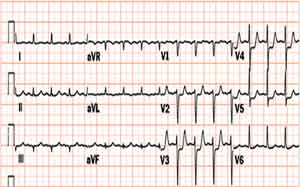Unstable angina non ST elevation myocardial infarction electrocardiogram
|
Unstable angina / NSTEMI Microchapters |
|
Differentiating Unstable Angina/Non-ST Elevation Myocardial Infarction from other Disorders |
|
Special Groups |
|
Diagnosis |
|
Laboratory Findings |
|
Treatment |
|
Antitplatelet Therapy |
|
Additional Management Considerations for Antiplatelet and Anticoagulant Therapy |
|
Risk Stratification Before Discharge for Patients With an Ischemia-Guided Strategy of NSTE-ACS |
|
Mechanical Reperfusion |
|
Discharge Care |
|
Case Studies |
|
Unstable angina non ST elevation myocardial infarction electrocardiogram On the Web |
|
FDA on Unstable angina non ST elevation myocardial infarction electrocardiogram |
|
CDC onUnstable angina non ST elevation myocardial infarction electrocardiogram |
|
Unstable angina non ST elevation myocardial infarction electrocardiogram in the news |
|
Blogs on Unstable angina non ST elevation myocardial infarction electrocardiogram |
|
to Hospitals Treating Unstable angina non ST elevation myocardial infarction electrocardiogram |
Editor-In-Chief: C. Michael Gibson, M.S., M.D. [1]; Associate Editors-In-Chief: Cafer Zorkun, M.D., Ph.D. [2]; Varun Kumar, M.B.B.S.; Lakshmi Gopalakrishnan, M.B.B.S.; Raviteja Guddeti, M.B.B.S. [3]
Overview
The EKG in patients with unstable angina can be variable. In some cases, no changes on EKG will be appreciated. In other cases, a resting EKG may show flipped or inverted T waves, ST segment depression, or non-specific ST-T changes. It is the first line of assessment in any patient suspected of having unstable angina.
Electrocardiogram in Unstable angina / NSTEMI
The resting electrocardiogram in the patient with unstable angina / non-ST elevation MI may show any of the following:
- No changes
- Non specific ST / T wave changes
- Flipped or inverted T waves
- ST depression as shown below. ST depression carries the poorest prognosis. Greater magnitudes of down sloping ST depression are associated with a high in-hospital, 30-day and 1-year mortality. 1 year MI or death rate in patients with new ST deviation (more than 1 mm from baseline) has been shown to be 11% compared to 6.8% in patients with isolated T-wave inversion.
Wellens' syndrome is an electrocardiographic manifestation of critical proximal left anterior descending (LAD) coronary artery stenosis in patients with unstable angina. It is characterized by symmetrical, often deep >2mm, T wave inversions in the anterior precordial leads. A less common variant is biphasic T wave inversions in the same leads.[1]
EKG Examples
Shown below is an EKG from a patient with unstable angina. ST depression in V2, V3,V4 and V6 can be noted:

Copyleft image obtained courtesy of ECGpedia,http://en.ecgpedia.org/wiki/Main_Page